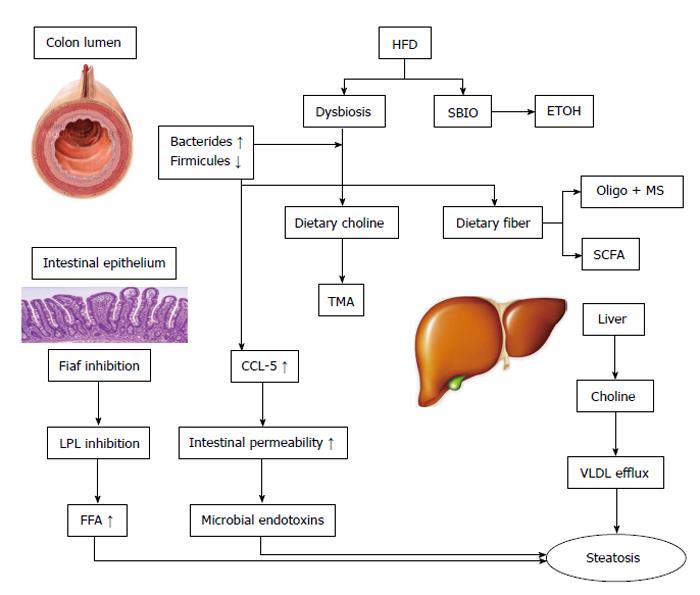Copyright
©The Author(s) 2015.
World J Hepatol. Jun 28, 2015; 7(12): 1679-1684
Published online Jun 28, 2015. doi: 10.4254/wjh.v7.i12.1679
Published online Jun 28, 2015. doi: 10.4254/wjh.v7.i12.1679
Figure 1 The effect of the intestinal microbiota on non-alcoholic fatty liver disease.
High fat diets (HFD) produce dysbiosis and small bowel intestinal overgrowth (SBIO). There is an increase in energy extraction and fermentation of dietary fibers to oligo- and mono-saccahrides and short chain fatty acids (SCFA). There is also an increase in ethanol (ETOH) production. The microbiota metabolize choline to trimethylamine (TMA). There is a choline deficiency which decreases very low-density lipoprotein (VLDL) efflux and hepatic steatosis. In addition the intestinal microbiota suppresses the production of fasting induced adipocyte factor (Fiaf) in intestinal epithelia, which increases the activity of lipoprotein lipase and the levels of free fatty acids (FFA). Dysbiosis results in a disruption of tight junctions in the enterocytes via chemokine (C-C motif) ligand 5 (CCL-5). The resulting increase in intestinal permeability results in the translocation of microbial products to the liver and inflammation; MS: Monosaccharides; LPL: Lipoprotein lipase.
- Citation: Abdul-Hai A, Abdallah A, Malnick SD. Influence of gut bacteria on development and progression of non-alcoholic fatty liver disease. World J Hepatol 2015; 7(12): 1679-1684
- URL: https://www.wjgnet.com/1948-5182/full/v7/i12/1679.htm
- DOI: https://dx.doi.org/10.4254/wjh.v7.i12.1679













